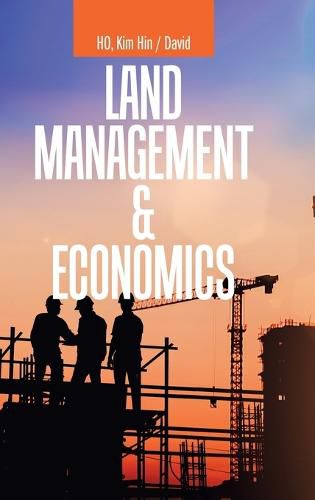Readings Newsletter
Become a Readings Member to make your shopping experience even easier.
Sign in or sign up for free!
You’re not far away from qualifying for FREE standard shipping within Australia
You’ve qualified for FREE standard shipping within Australia
The cart is loading…






This title is printed to order. This book may have been self-published. If so, we cannot guarantee the quality of the content. In the main most books will have gone through the editing process however some may not. We therefore suggest that you be aware of this before ordering this book. If in doubt check either the author or publisher’s details as we are unable to accept any returns unless they are faulty. Please contact us if you have any questions.
This book is concerned with a unique, overall land policy optimization model, under active government policy, resulting in the sustainable effectiveness and efficiency of land policy. Such a model distinguishes it from the highly specific urban-planning land use optimization model, meant for optimizing land use specification, strategic land uses, land use restrictions and control, like zoning. Policy input is concerned with a hierarchical and structural definition of policy while ‘Additionality’ looks at land-policy output (outcome) variables, impacting broader land policy efficiency and effectiveness goals, their associated output indicators and the interaction with the macroeconomy. Long run urban policy-macroeconomy interaction is modeled in a contemporaneous cointegration model estimation, involving different sectors of the economy. The model looks at the equilibrium and optimal land-using economic activities. A dynamic interaction of land policy outcomes and their economic implications is discussed via cointegration tests and modelling. This book develops a rigorous system-dynamics-based computable general equilibrium model for direct real estate market uncertainty i.e. the frequent mismatch between office demand and supply under the impact of limited land constraint, the domestic common stock market, the macro economy and macroeconomic policy. Such dynamic interaction is structured under the demand-side and supply-side aspects. The book looks at the binomial option-pricing model by Cox, Ross and Rubinstein, to model the risk-neutral process for short term interest rates, common stock prices and Housing & Development Board (HDB) resale flat prices. Singapore’s Main Upgrading Program (MUP) is a heavily subsidized and highly targeted. Since 1992, the HDB has budgeted some S$3 billion to finance the MUP policy. A positive impact is the asset value enhancement of the HDB flats within the upgraded precincts. MUP subsidies vary significantly with the corresponding option premium. A 3-Room HDB flat owner is more inclined to opt for upgrading while the option premium is deemed to be less attractive for upgrading by the 4-Room HDB flat owner. Residents’ satisfaction level with town council (TC) services are examined, under different political parties. The concern is to ascertain a housing finance model, which analyzes the affordability of household borrowers for purchasing resale public housing. With Central Provident funds (CPF) usage, total interest paid over the loan life is significantly reduced. CPF as a financial buffer significantly reduce default risks for lender and household borrower.
$9.00 standard shipping within Australia
FREE standard shipping within Australia for orders over $100.00
Express & International shipping calculated at checkout
This title is printed to order. This book may have been self-published. If so, we cannot guarantee the quality of the content. In the main most books will have gone through the editing process however some may not. We therefore suggest that you be aware of this before ordering this book. If in doubt check either the author or publisher’s details as we are unable to accept any returns unless they are faulty. Please contact us if you have any questions.
This book is concerned with a unique, overall land policy optimization model, under active government policy, resulting in the sustainable effectiveness and efficiency of land policy. Such a model distinguishes it from the highly specific urban-planning land use optimization model, meant for optimizing land use specification, strategic land uses, land use restrictions and control, like zoning. Policy input is concerned with a hierarchical and structural definition of policy while ‘Additionality’ looks at land-policy output (outcome) variables, impacting broader land policy efficiency and effectiveness goals, their associated output indicators and the interaction with the macroeconomy. Long run urban policy-macroeconomy interaction is modeled in a contemporaneous cointegration model estimation, involving different sectors of the economy. The model looks at the equilibrium and optimal land-using economic activities. A dynamic interaction of land policy outcomes and their economic implications is discussed via cointegration tests and modelling. This book develops a rigorous system-dynamics-based computable general equilibrium model for direct real estate market uncertainty i.e. the frequent mismatch between office demand and supply under the impact of limited land constraint, the domestic common stock market, the macro economy and macroeconomic policy. Such dynamic interaction is structured under the demand-side and supply-side aspects. The book looks at the binomial option-pricing model by Cox, Ross and Rubinstein, to model the risk-neutral process for short term interest rates, common stock prices and Housing & Development Board (HDB) resale flat prices. Singapore’s Main Upgrading Program (MUP) is a heavily subsidized and highly targeted. Since 1992, the HDB has budgeted some S$3 billion to finance the MUP policy. A positive impact is the asset value enhancement of the HDB flats within the upgraded precincts. MUP subsidies vary significantly with the corresponding option premium. A 3-Room HDB flat owner is more inclined to opt for upgrading while the option premium is deemed to be less attractive for upgrading by the 4-Room HDB flat owner. Residents’ satisfaction level with town council (TC) services are examined, under different political parties. The concern is to ascertain a housing finance model, which analyzes the affordability of household borrowers for purchasing resale public housing. With Central Provident funds (CPF) usage, total interest paid over the loan life is significantly reduced. CPF as a financial buffer significantly reduce default risks for lender and household borrower.